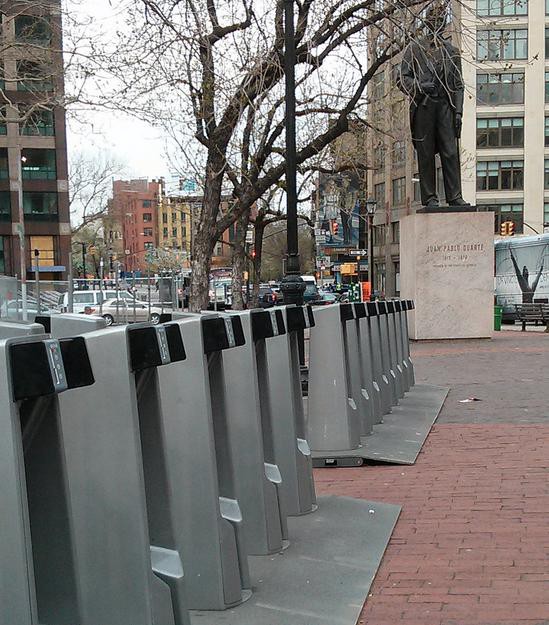Double Digit Diabetes: We Did It!
Look to your left. Then look to your right. Now look at eight other people. At least one of them has diabetes. Probably the one drinking soda.
Rich People Money Prettier Than Regular People Money

Yeah, fine, there’s a new hundred dollar bill. Whoop-de-damn-doo. The $1 bill is fifty years old in its current configuration, and I see a lot more of those than I do hundreds. I’m BORED. Change up the single for me already! I mean, I get it, the government wants to phase out paper money altogether so that it can further its plan of frustrating my every move by forcing me to stand behind an even longer line of idiots who are unable to find their debit cards or swipe them properly so that the commission of a single-item purchase becomes a marathon event and you just want to kill everybody and yourself, but still, let’s give poor George a makeover while we’re waiting. Anyway, these are my thoughts on currency. I’m aware that you’ve been clamoring for clarity on this issue, and now you know.
Moon Useless
“What would happen to the Earth if the moon was destroyed?” Apart from the MASSIVE REJOICING and WAVE OF GOOD FEELINGS BROUGHT FORTH UPON THE LAND, pretty much nothing. Things would get a little wobbly, but it seems like a fair trade-off. NOW can we destroy the moon? Please?
How Much Less Money Is The 'New York Times' Really Making Now?

Let’s just do facts, right? (Footnoted with sources; otherwise from NYT Co. self-report.)
Total Q1 revenue this year: $475.4 million.
Total Q1 revenue in 2012: $499.4 million.
Total Q1 revenue in 2011: $566.5 million.
Total Q1 revenue in 2010: $587.9 million.
Total Q1 revenue in 2009: $609.0 million.
Total Q1 revenue in 2008: $747.9 million.
Total Q1 revenue in 2007: approx $740 million.*
Total Q1 revenue in 2006: $832 million.*
Total Q1 revenue in 2005: $806 million.*
Total Q1 revenue in 2004: $773.8 million.*
Total Q1 revenue in 2003: $783.7 million.*
Percentage Of People Who Were Idiots In The '90s Corrected
“Because of an editing error, the Skin Deep column last Thursday, about employees who feel the need to conceal their tattoos at work, misstated one of the findings of a Pew Research poll from 2010 about Americans with tattoos. It found that 32 percent of people aged 30 to 45 have a tattoo, not that 32 percent of Americans with tattoos are 30 to 45 years old.”
Beware of Falling Children
Eeek it’s that day, it’s Bring Your Tiny Animal To Work Day! (Also other things.)
Now We Have So Many Bike Racks And No Bikes
by Ben Dolnick

There’s a strange, wonderful short story by Donald Barthelme about a balloon that appears one day on Fourteenth Street and grows, like a low-hanging blimp, until it covers a good deal of Manhattan. It becomes an object of widespread puzzlement and fascination. Children leap across its surface. Art critics analyze its colors. City officers conduct secret nighttime tests to better understand it.
For the past couple of weeks, Fort Greene has been living out its own strange version of “The Balloon.” On a handful of corners, seemingly overnight, bike racks have appeared. And not just any bike racks, but city bike racks. Or is it citibike racks? These, in any event, are the bike racks that we’ve been hearing about for months, the harbingers of New York’s new bike-sharing system — apparently called Citi Bike℠ — that will, depending on your perspective, transform the city into either an Elysium of convenience and health or a corporate-sponsored hell-scape.
The bikes themselves, though, won’t arrive until late May. Which means that for a while here, we’re living with a kind of accidental urban art installation. There the racks sit — sometimes on sidewalks, sometimes in what were, just hours before, parking spaces — like rows of water fountains designed by Donald Judd. They have no present function except to irritate, to excite, to bewilder.
My neighbors and I stand peering at them, arms defensively crossed, asking each other, “Who’s going to ride all these things?” “How much will it cost?” “What about helmets?” “What about parking?” I have, in the weeks since the racks appeared, heard more public conversation about gentrification and urbanism than in all the years that I’ve lived in New York. Barthelme’s city-dwellers decorate their balloon with paper lanterns and obscene fliers; we adorn ours with anxiety and indignation.
I’d known that the bike-share system was coming. I’d snorted with mild derision at the delays; I’d imagined, to the extent that I’d bothered to imagine it at all, that this, like the Second Avenue subway or the Big Dig, would be one of those city projects notable only for its state of permanent imminence.
If buttonholed by someone with a clipboard, though, I would have counted myself as a supporter. I’d ridden similar bikes in San Antonio and Chattanooga and, though it was hard to picture how the experience would translate onto Fulton Street, I’d felt a slight future-thrill, as I did the first time I signed a credit card receipt with my finger on an iPhone. I had high but indistinct hopes.
Now that the racks are actually here, though, my response is considerably more shaded. The strange thing about public art is that it isn’t just divisive within communities (see the endless battles over Christo’s plan to “wrap” the Arkansas River); it can be divisive within individual minds. I seem to feel something new about the racks each time I walk past them.
One the one hand: Do they really need to be so large? Must there be seven of the stations within a five-block radius of my apartment? And isn’t there something sinister about those massive blue-glass poles, like the antennas of newly landed spaceships?
This is the part of me that harumphs when what used to be a hardware store becomes a beer garden, or when an intersection becomes an umbrella-bedecked pedestrian plaza. These grumbles are both deeply felt and slightly embarrassed. I’ve enjoyed that beer garden’s pretzels, after all; I’ve spent afternoons happily reading in that plaza. I’ve been living in Fort Greene for nine years now — just long enough to complain about how much the neighborhood has changed, in other words, and just short enough to still count as part of the change that I’m complaining about.
But there’s another, less gloomy part of me that occasionally responds to the racks with something like giddiness.
Remember in 2001, before the Segway was introduced, when there were fevered reports that there was an invention coming that would change the modern city forever? My friends and I used to sit around imagining what such a thing could be — a system of pneumatic tubes, a la the Jetsons? hovercrafts powered by the warmth of their riders’ bodies? — and I distinctly remember the letdown when we learned that the invention was… a two-wheeled scooter.
Well, what if these bikes — these two-wheeled vehicles — really are the innovation that we’ve been waiting for? What if, ten years from now, we’ll look back on that peculiar era when we didn’t all ride around on city-issued bikes, when we didn’t all carry helmets in our backpacks, when we might actually have walked from Fort Greene to Prospect Park, or even taken the G train? Maybe it will be like trying to remember the years before the internet. What did we do with ourselves? Did we really use phone-books? Did we really go to bed, content in the knowledge that the sports scores would be waiting for us when we woke up in the morning?
At these moments I stand before the racks as if they were the heads on Easter Island. How astonishing that people can do such things, I think. What a strange and creative species we are.
At the end of “The Balloon,” the story’s narrator confesses that the balloon — the whole twenty-two day, city-consuming operation — as merely his way of expressing that he missed his girlfriend, who was traveling in Norway. Now that she’s returned, he orders the balloon taken down, and trailer trucks drive the deflated thing off to a storage facility in West Virginia. City life resumes as before.
Our bike-racks won’t, of course, be carted away at the end of this interval. On the contrary, they’ll proliferate into other neighborhoods; they’ll become home to fleets of bright-blue bikes; they’ll get dirty; they’ll have price-increases and software malfunctions; they’ll become part of our urban furniture.
So I savor this peculiar stretch before our dreads are confirmed or our hopes are exceeded, in which we don’t yet know whether this experiment will stand as the grandest testament to hubris since Ozymandias’ legs or the greatest urban triumph since the subway system. All we have is the racks themselves. There they sit, gleaming under their own faint blue light, mute and strange — empty of bikes, full of what we think of them.
Ben Dolnick is the author of the forthcoming novel At the Bottom of Everything.
New York City, April 23, 2013

★ Weak, blowing drizzle dampened the middle of the day. The light was like looking up from the bottom of a basement utility sink full of cold-cycle wash water. Two young foreign women, one in pink Crocs over tights, were searching for the Prada store. By the afternoon, the drizzle had quit and gone away; sometime after dark, the clouds went, too, and toward midnight the stars shone down.
Eric Bogosian Is 60
Related: The ’80s seemed kind of dull at the time, but I guess everything looks a little weirder in the rear-view mirror.
